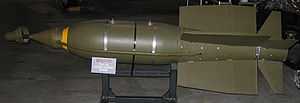BOLT-117
 |
| BOLT-117 (GBU-1/B) |
| Primary Function: |
750 lb (340 kg) unpowered guided weapon |
| Length: | |
| Diameter: | |
| Range: | ca. 4 km |
The Texas Instruments BOLT-117 (BOmb, Laser Terminal-117), retrospectively redesignated as the GBU-1/B (Guided Bomb Unit)[1] was the world's first laser-guided bomb (LGB). It consisted of a standard M117 750-pound bomb case with a KMU-342 laser guidance and control kit. This consisted of a gimballed laser seeker on the front of the bomb and tail and control fins to guide the bomb to the target. These latter used the bang-bang method of control where each control surface was either straight or fully deflected. This was inefficient aerodynamically, but reduced costs and minimized demands on the primitive on-board electronics.
It was commissioned by the United States Air Force in 1967 and successfully completed a combat evaluation in 1968. The Weapon System Officer in the back seat of a F-4 Phantom II fighter bomber used a hand-held Airborne Laser Designator to guide the bombs, but half of the LGBs hit their targets despite the difficulties inherent in keeping the laser on the target. Placement of the control surfaces on the rear of the bomb proved to be less than ideal as it limited the ability of the fins to control the bomb's trajectory. Only a limited number of BOLT-117 bombs were produced before it was discontinued in favour of the more accurate Paveway I family of guidance kits that moved the control fins to the front of the bomb.
The impact of the BOLT-117 on aerial warfare was revolutionary. Laser guidance kits turned standard "dumb" ordnance into "smart bombs," yielding a 100-fold increase in effectiveness compared with free-falling, unguided bombs.
See also
References
External links
 |
Wikimedia Commons has media related to BOLT-117. |
|
|---|
| | General | |
|---|
| | Military | |
|---|
| | Accidents / incidents | |
|---|
| | Records | |
|---|
| | Misc. | |
|---|
|

